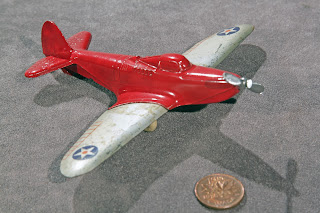Today's article is about Kenton Sulkies. Kenton was a company that produced fine cast iron toys in the early 1900's. One of their beautiful toys was their sulky- a type of horse-racing cart. These toys are called "pull toys", as a small rope or string is attached to the open circle at the front of the hoof. Initially, I purchased the golden one below to re-sell, but decided to keep it as a present to my wife to remind us of her great late father George. George used to have racehorses and raced them in Montreal (Quebec,Canada) at a racetrack called Blue Bonnets, which later became the Hippodrome. Eventually, the racetrack closed, and will soon become a development of some sort or another. However, I digress.
During my buying in early October-December of 2011, I came across 2 other of these Kenton toys. When my wife saw the multi-coloured one, she immediately liked it more than the golden yellow one, and I of course exchanged it for her.
I purposely added the 9 golden-yellow images for you to peruse the fine detail of this fine toy!
Now the grey sulky below.

And finally all 3 together
I might as well explain tin brief what the cast iron process is. A mold (Canadian spelling, eh!) is a cut-out shape made from a material that will not melt. In the above case, the mold is the driver, the wheels, and the horse. With the horse and driver, a left mold and a right mold are made. The iron metal
(a composite) is melted at its' melting point of 1260 Celcius or 2300 Fahrenheit, and then is poured into the mold through a hole in the top. Once poured, the casting cools for a few minutes, then the cast-iron worker carefully separates the newly-formed half from the mold.
Once the 1/2 shape is completely cool, it is filed down to remove rough edges and polished to allow for painting. Holes are made in identical positions on the left and right sides, and a small nail-sized solid-metal cylinder is passed the holes. The ends of the cylinder are then carefully hammered or a huge machine press is carefully positioned to the form a dome at each end to hold the 2 pieces together.
You don't always have semi-circular end caps of the cylinder. Instead the hammered or pressed end is carefully sanded down just to the point of blending it with the 2 halves, and then is painted over.
I'll let you search out these held-in-place points. Don't forget that double-clicking on a photo will enlarge it.
Because this process is "crude" in the sense of looking rough, many times, counter-fitters will produce fakes of the more expensive models. You can usually know a fake, because the forger will use a screw instead of the longer and harder and more delicate process of hammering the cylinder.



















































